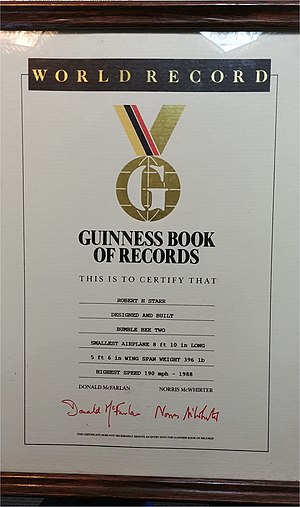avia.wikisort.org - Aeroplane
The Starr Bumble Bee II was an experimental aircraft designed and built specifically to acquire the title of “The World’s Smallest Airplane”.
| Bumble Bee II | |
|---|---|
 | |
| Guinness certificate Starr Bumble Bee I on display at Pima Air & Space Museum, Tucson, Arizona | |
| Role | Record Breaker |
| Manufacturer | Homebuilt |
| Designer | Robert H. Starr |
| First flight | April 2, 1988 |
| Status | Destroyed[1] |
| Primary user | Robert H. Starr |
| Number built | 1 |
| Developed from | Starr Bumble Bee I |
Design and development
The Bumble Bee II was designed, and built by Robert H. Starr in Phoenix, Arizona [1] with the intent of breaking the record for world's smallest biplane. Robert Starr had been deeply involved with the development of aircraft holding previous “smallest airplane” titles, including his own Bumble Bee I, which temporarily lost the record of world's smallest aircraft to the Baby Bird designed by Donald Stits, that is until Bumble Bee II flew and regained the Guinness record. The design of the Bumble Bee II is similar to Starr's original Bumble Bee I except the Bumble Bee II was smaller and lighter[2] Both aircraft were biplanes.[3] Both aircraft had negative staggered, cantilevered wings and conventional (tail dragger) landing gears. The fuselage of the Bumble Bee II was constructed of welded steel tubing with sheet metal covering, while the wings were covered in aircraft plywood.[4] The power plant was a Continental C85 4 – cylinder air-cooled horizontally opposed cylinder engine (Boxer Motor) that produced 85 hp.[2] The upper wings had flaps and the lower wings had ailerons. All wing airframe structures were equipped with tip plates to enhance the lift coefficient. The airplane had a small cockpit with the rudder pedals located under the engine compartment toward the front of the cowling.
Operational history
The Bumble Bee II was flown on April 2, 1988, at Marana Airport[5] just outside of Tucson, Arizona to achieve the world record for the smallest piloted airplane. According to the Guinness Book of World Records, the Bumble Bee II crashed and was destroyed during the 3rd flight on the 5th of May, 1988.[1] At 400 feet of altitude,[6] the engine failed on a down-wind leg.[7] The crash destroyed the Bumble Bee II and severely injured Robert Starr,[1] who made a full recovery.[6]
Aircraft on public display

The Bumble Bee I is on public display at the Pima Air & Space Museum.[3] [1]
Naming
Starr named the aircraft after the bumble bee because bumble bees allegedly do not have enough wing area to fly according to standard aerodynamics, and engineers and pilots made a similar statement about Starr's Bumble Bee I and II, yet both flew.[6]
Specifications
Data from Guinness Book of World Records,[1] Disciples of Flight,[2] Aviation Trivia [6]
General characteristics
- Crew: One
- Length: 8 ft 10 in (2.7 m)
- Wingspan: 5 ft 6 in (1.68 m)
- Height: 3 ft 11 in (1.2 m)
- Airfoil: 23012
- Empty weight: 396 lb (180 kg)
- Max takeoff weight: 574 lb (260 kg)
- Fuel capacity: 3 US gallons (11.35 litres)
- Powerplant: 1 × Continental C85 4-cylinder air-cooled horizontally opposed piston engine, 85 hp (63 kW)
Performance
- Maximum speed: 165 kn (190 mph, 305 km/h)
- Cruise speed: 130 kn (150 mph, 241 km/h)
- Stall speed: 75 kn (86 mph, 139 km/h)
- Service ceiling: 14,000 ft (4,270 m)
- Rate of climb: 4,500 ft/min (23 m/s)
References
- "Smallest Aircraft". Guinness World Records. Retrieved 2021-05-31.
- "Flight of the Bumble Bee Airplane". Disciples of Flight. 19 April 2013. Retrieved 2021-05-31.
- "Starr Bumble Bee - Pima Air and Space Museum - Tucson, Arizona". Pima Air and Space Museum. Retrieved 2021-05-31.
- "Building the Bumble Bee". Youtube. Archived from the original on 2021-12-21. Retrieved 2021-05-31.
- "Bumble Bee II, The Guinness Book Records Holder". Youtube. Retrieved 2021-05-31.
- "Starr Bumble Bee II". Aviation Trivia. Retrieved 2021-05-31.
- "Starr Bumble Bee II – Aircraft of the month". Gould Aero. 13 November 2020. Retrieved 2021-05-31.
External links
На других языках
- [en] Starr Bumble Bee II
[fr] Starr Bumble Bee II
Le Starr Bumble Bee II était le plus petit avion piloté au monde. Il a été construit par Robert H. Starr. Son premier vol a eu lieu le 8 mai 1988. Le Bumble Bee II s'est écrasé le même jour en raison d'une panne moteur. Robert Starr a été grièvement blessé dans l'accident, mais il s'est complètement remis de ses blessures.Другой контент может иметь иную лицензию. Перед использованием материалов сайта WikiSort.org внимательно изучите правила лицензирования конкретных элементов наполнения сайта.
WikiSort.org - проект по пересортировке и дополнению контента Википедии